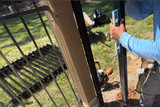Concrete vs. Expanding Foam: Choosing the Right Material for Setting Fence Posts
Fence installation might seem straightforward, but one critical decision can impact its longevity and stability: what material to use for setting the posts. Among the various options available, concrete and expanding foam stand out as popular choices. Each has its advantages and disadvantages, and understanding the differences between them is essential for making an informed decision. Let's delve into the pros and cons of setting fence posts with concrete versus expanding foam.
Concrete: The Traditional Choice
Concrete has long been the go-to material for setting fence posts, and for good reason. It offers several benefits that make it a reliable option for ensuring sturdy and durable fences.
Pros:
- Strength and Stability: Concrete provides excellent structural support, preventing fence posts from shifting or leaning over time, especially in regions with harsh weather conditions or heavy soil.
- Durability: Once set, concrete resists decay and degradation, ensuring the longevity of your fence. It can withstand moisture, rot, and pests, maintaining its integrity for years.
- Cost-Effectiveness: Concrete is relatively affordable and widely available, making it a cost-effective choice for many homeowners and contractors.
Cons:
- Time-Consuming Installation: Working with concrete can be labor-intensive and time-consuming. Mixing, pouring, and allowing sufficient curing time adds to the overall installation timeline.
- Potential for Cracking: Improperly mixed or poured concrete may crack over time, compromising the stability of the fence. Additionally, water accumulation within the concrete can lead to frost heave in colder climates.
- Limited Adjustability: Once the concrete sets, it becomes challenging to make adjustments to the fence alignment or post placement without significant effort.
Expanding Foam: The Modern Alternative
In recent years, expanding foam has emerged as an alternative to traditional concrete for setting fence posts. This lightweight and versatile material offer its own set of advantages and drawbacks.
Pros:
- Quick Installation: Expanding foam simplifies the installation process, requiring less time and effort compared to concrete. It expands rapidly upon application, filling voids and tightly securing the post in position within minutes.
- Minimal Mess and Disruption: Unlike concrete, expanding foam produces minimal mess during installation, reducing cleanup time and inconvenience. It also eliminates the need for heavy mixing equipment and reduces the risk of spills or stains.
- Flexibility and Adjustability: Expanding foam allows for greater flexibility during installation, enabling easier adjustments to the fence alignment or post placement. This flexibility can be particularly advantageous in uneven or rocky terrain.
Cons:
- Less Structural Support: While expanding foam provides initial stability, it may not offer the same level of long-term structural support as concrete, especially in areas prone to high winds or soil movement.
- Susceptibility to Moisture: Expanding foam is vulnerable to moisture infiltration, which can compromise its adhesive properties over time. In regions with heavy rainfall or frequent irrigation, this can lead to post instability or premature degradation.
- Cost Considerations: Expanding foam tends to be more expensive than concrete on a per-unit basis. However, the overall cost may vary depending on factors such as installation time and labor expenses.
Making the Right Choice
When it comes to setting fence posts, both concrete and expanding foam offer distinct advantages and drawbacks. The choice between the two ultimately depends on factors such as budget, installation time, environmental conditions, and personal preference.
For projects where strength, durability, and long-term stability are paramount, concrete remains a tried-and-true option. Its proven track record makes it ideal for fences intended to withstand the test of time.
On the other hand, expanding foam offers a convenient and efficient alternative, particularly for DIY enthusiasts or projects requiring rapid installation with minimal disruption. While it may not provide the same level of structural support as concrete, it can be a suitable choice for fences in less demanding environments or temporary installations.
In conclusion, whether you opt for concrete or expanding foam, proper installation techniques and regular maintenance are key to ensuring the longevity and performance of your fence. By weighing the pros and cons of each material and considering your specific needs, you can make an informed decision that best suits your project requirements.
Recent Posts
-
Experience, Reputation, Customer Service
Here’s why buying from OnlineFenceStore.com is a strong choice for fencing products: Key Advantages …Aug 13th 2025 -
How to Order Fence from OnlineFenceStore.com: A Step-by-Step Guide
How to Order Fence from OnlineFenceStore.com: A Step-by-Step Guide Ordering a fence online has never …Jul 30th 2025 -
Plumb vs. Level: Understanding the Difference in Fence Post Installation
When it comes to installing a fence, getting the job done right the first time is crucial. One of th …Jun 19th 2025







